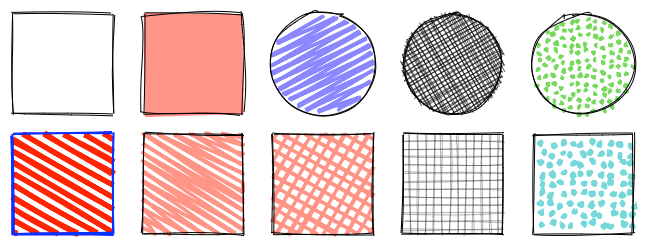
GitHub activity chart with Rough.js
create a simple GitHub activity chart for your personal website!
- 7 minsSo the other day I had a sudden, irresistible urge to make something using the Rough.js library, which lets you make gorgeously sketchy graphics. The urge probably originated from the fact that I had exams I was meant to study for.

I figured that since I’ve got a healthy amount of GitHub activity lying around, I might as well use this opportunity to put that activity to good use: by making a cute little chart of how much git commit I’ve been doing recently.

To get started, you’ll want to include Rough.js and d3 libraries somewhere in your header:
<script src="https://cdn.jsdelivr.net/npm/roughjs@3.1.0/dist/rough.min.js"></script>
<script src="https://cdnjs.cloudflare.com/ajax/libs/d3/5.12.0/d3.min.js"></script>
And set up a div to populate with your chart:
<div id="canvas-container" height="150px">
<canvas id="canvas"></canvas>
</div>
For contribution data, I opted to use the custom API used by sallar/github-contributions-chart, which provides the contribution data in a nice and easy-to-use format (it does not seem like GitHub offers an official way to get the data in a format like this):
{
"years":[ /* yearly summaries */ ],
"contributions":[
// ...
{
"date":"2019-11-03", // future days are included with "count": 0
"count":0,
"color":"#c6e48b",
"intensity":0
},
{
"date":"2019-11-02",
"count":12,
"color":"#c6e48b",
"intensity":1
},
{
"date":"2019-11-01",
"count":1,
"color":"#c6e48b",
"intensity":1
},
{
"date":"2019-10-31",
"count":6,
"color":"#c6e48b",
"intensity":1
},
{
"date":"2019-10-30",
"count":33,
"color":"#7bc96f",
"intensity":2
},
// ...
]
}
Here’s the entire snippet, edited slightly for brevity and with comments added explaining what is going on:
const user = 'bobheadxi';
const corsAnywhere = 'https://cors-anywhere.herokuapp.com';
function drawChart() {
// start off by requesting contribution data. as of oct 2020, this API now requires CORS
// enabled - we use the cors-anywhere proxy service to make the request instead.
return fetch(`${corsAnywhere}/https://github-contributions.now.sh/api/v1/${user}`)
.then((resp) => resp.json()) // turn that request data into JSON
.then((data) => {
// figure out what our current dimensions are - I chose to always let the
// height be the same
const maxWidth = document.getElementById('canvas-container').clientWidth;
const maxHeight = 150;
// force the canvas to fill the container
const canvas = document.getElementById('canvas');
canvas.width = `${maxWidth}`;
canvas.height = `${maxHeight}`;
// the API provides a bunch of zeroes for days in the future, (see the
// sample data above) so I strip leading zeroes out. this also has the
// "benefit" of not showing recent inactivity on your generated chart ;
// you could probably improve this by actually figuring out which entry
// corresponds to the current date, but I was too lazy
let firstNonZero = 0;
for (let i = 0; i < data.contributions.length; i++) {
if (data.contributions[i].count > 0) {
firstNonZero = i;
break;
}
}
// based on the width, calculate how many days of activity to show so that
// we get nice-looking bars to fill the space
const barWidth = 8;
const barGap = barWidth / 4;
const days = Math.floor(maxWidth / (barWidth + barGap));
// get the most recent days (as we just calculated) and turn the array of
// contributions objects into an array of numbers, then reverse it to get
// the most recent ones first.
const counts = data.contributions
.slice(firstNonZero, firstNonZero+days)
.map(c => c.count)
.reverse();
// get the max so we can scale the bars to kind of fill the height
const max = d3.max(counts);
const heightFlex = maxHeight / (max + 4);
// get your canvas, and iterate over the data to draw in the bars. in
// hindsight, the load time can probably be improved by merging this with
// the array manipulations earlier. as textbook authors like to say,
// "we'll leave this as an exercise for the reader".
const rc = rough.canvas(canvas);
counts.forEach((d, i) => {
// calculate appropriate dimensions for this bar. we want to position
// the bars with a bit of a gap to avoid having the canvas crop out the
// "sketchy" rectangle borders (hence the +1 and -1), and give each bar
// a bit of space to flex their sketchiness.
const barHeight = heightFlex * d;
const dim = {
x: i * (barWidth + barGap) + 1,
y: maxHeight - barHeight - 1,
w: barWidth,
h: barHeight,
};
// I choose green because GitHub uses green, but you can adjust this
// as you wish!
rc.rectangle(dim.x, dim.y, dim.w, dim.h, { fill: 'green' });
});
})
.catch((err) => console.error(`chart generation error`, { err }));
}
// draw the chart on page load and scale it when the window size changes!
window.onload = drawChart;
window.onresize = drawChart;
It’s not the fastest thing in the world and could probably do with a lot of improvement, but it works for now!